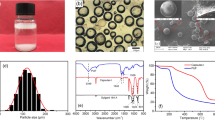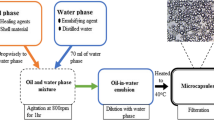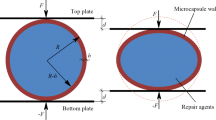Abstract
The microencapsulated self-healing composite (SHC) has received much attention for their ability to automatically detect and repair cracks. However, the general micromechanical models relating to SHC did not adequately consider the complex interaction between components and the interfacial transition zone. To address these problems, the four-phase micromechanical model containing core-wall-interface-matrix is proposed based on the composite-sphere theory and the Mori–Tanaka method in this study, and the effective properties of SHC are investigated by regarding the parameter of microscopic component as variables. The results showed that the predictive effective properties of SHC lie between the upper and lower limits obtained from the investigations of Walpole, indicating that the proposed micromechanical model is feasible, and the effect of interfacial strength and interfacial thickness on the properties of SHC is significant, indicating that it is necessary to build the micromechanical model consisting of the interfacial phase in this study, the core-to-wall ratio, size, and the strength of capsule wall have high sensitivity to the effective properties of SHC. These results can help investigate the influence of individual components on the properties of SHC, which are useful to guide the selection of individual components for functional materials.











Similar content being viewed by others
References
Hilloulin, B., Van Tittelboom, K., Gruyaert, E., De Belie, N., Loukili, A.: Design of polymeric capsules for self-healing concrete. Cement Concr. Compos. 55, 298–307 (2015)
Rodriguez, R., Bekas, D.G., Flórez, S., Kosarli, M., Paipetis, A.S.: Development of self-contained microcapsules for optimised catalyst position in self-healing materials. Polymer 187, 122084 (2020)
Wang, X., Zhang, J., Han, R., Han, N., Xing, F.: Evaluation of damage and repair rate of self-healing microcapsule-based cementitious materials using electrochemical impedance spectroscopy. J. Clean. Prod. 235, 966–976 (2019)
Jiang, Z., Li, J., Li, W.: Preparation and characterization of autolytic mineral microsphere for self-healing cementitious materials. Cement Concr. Compos. 103, 112–120 (2019)
Christopher, J.P., Sultan, M.T., Selvan, C.P., Irulappasamy, S., Safri, S.: Manufacturing challenges in self-healing technology for polymer composites-a review. J. Market. Res. 9(4), 7370–7379 (2020)
Litina, C., Al-Tabbaa, A.: First generation microcapsule-based self-healing cementitious construction repair materials. Constr. Build. Mater. 255, 119389 (2020)
Ozaki, S., Osada, T., Nakao, W.: Finite element analysis of the damage and healing behavior of self-healing ceramic materials. Int. J. Solids Struct. 100, 307–318 (2016)
Su, Y., Ouyang, Q., Zhang, W., Li, Z., Guo, Q., Fan, G., Zhang, D.: Composite structure modeling and mechanical behavior of particle reinforced metal matrix composites. Mater. Sci. Eng., A 597, 359–369 (2014)
Sheng, P., Zhang, J., Ji, Z., Wang, S.: Fem simulation and optimization on the elastic modulus and thermal expansion ratio of polymer-mineral composite. Constr. Build. Mater. 167, 524–535 (2018)
Zhang, H., Sheng, P., Zhang, J., Ji, Z.: Realistic 3d modeling of concrete composites with randomly distributed aggregates by using aggregate expansion method. Constr. Build. Mater. 225, 927–940 (2019)
Wang, X., Yang, Z., Jivkov, A.P.: Monte Carlo simulations of mesoscale fracture of concrete with random aggregates and pores: a size effect study. Constr. Build. Mater. 80, 262–272 (2015)
Wang, X.F., Han, R., Tao, J., Han, T.L., Zhu, G.M., Tang, J.N., Han, N.X., Xing, F.: Identification of mechanical parameters of urea-formaldehyde microcapsules using finite-element method. Compos. B Eng. 158, 249–258 (2019)
Ahmed, A., Sanada, K., Fanni, M., Abd El-Moneim, A.: A practical methodology for modeling and verification of self-healing microcapsules-based composites elasticity. Compos. Struct. 184, 1092–1098 (2018)
Mauludin, L.M., Zhuang, X., Rabczuk, T.: Computational modeling of fracture in encapsulation-based self-healing concrete using cohesive elements. Compos. Struct. 196, 63–75 (2018)
Li, W., Jiang, Z., Yang, Z., Yu, H.: Effective mechanical properties of self-healing cement matrices with microcapsules. Mater. Des. 95, 422–430 (2016)
Voigt, W.: Ueber die beziehung zwischen den beiden elasticitätsconstanten isotroper körper. Ann. Phys. 274, 573–587 (1889)
Reuss, A.: Berechnung der fließgrenze von mischkristallen auf grund der plastizitätsbedingung für einkristalle. Zamm-zeitschrift Fur Angewandte Mathematik Und Mechanik 9, 49–58 (1929)
Hashin, Z., Shtrikman, S.: A variational approach to the theory of the elastic behaviour of multiphase materials. J. Mech. Phys. Solids 11, 127–140 (1963)
Christensen, R.N., Lo, K.H.: Solutions for effective shear properties in three phase sphere and cylinder models. J. Mech. Phys. Solids 27, 315–330 (1979)
Herve, E., Zaoui, A.: n-layered inclusion-based micromechanical modelling. Int. J. Eng. Sci. 31(1), 1–10 (1993)
Mori, T., Tanaka, K.: Average stress in matrix and average elastic energy of materials with misfitting inclusions. Acta Metall. 21(5), 571–574 (1973)
Young, B.A., Fujii, A.M., Thiele, A.M., Kumar, A., Sant, G., Taciroglu, E., Pilon, L.: Effective elastic moduli of core-shell-matrix composites. Mech. Mater. 92, 94–106 (2016)
Falzone, G., Falla, G.P., Wei, Z., Zhao, M., Kumar, A., Bauchy, M., Neithalath, N., Pilon, L., Sant, G.: The influences of soft and stiff inclusions on the mechanical properties of cementitious composites. Cement Concr. Compos. 71, 153–165 (2016)
Wang, Z., Zhang, Q., Liu, J., Fu, L.-Y.: Effective moduli of rocks predicted by the Kuster-Toksóz and Mori-Tanaka models. J. Geophys. Eng. 18(4), 539–557 (2021)
ShahriarQuayum, Md., Xiaoying Zhuang, T.R.: Computational model generation and rve design of self-healing concrete. Front. Struct. Civil Eng. 9(4), 383 (2015)
Walpole, L.: On bounds for the overall elastic moduli of inhomogeneous systems-i. J. Mech. Phys. Solids 14(3), 151–162 (1966)
Xu, P.: Mechanical properties and interfacial properties of urea-formaldehyde resin microcapsules embedded in cementitious materials. Master’s thesis, Shenzhen University (2020)
Boutaleb, S., Zaïri, F., Mesbah, A., Naït-Abdelaziz, M., Gloaguen, J.M., Boukharouba, T., Lefebvre, J.M.: Micromechanics-based modelling of stiffness and yield stress for silica/polymer nanocomposites. Int. J. Solids Struct. 46(7), 1716–1726 (2009)
Pan, J., Bian, L., Gao, M., Liu, W., Zhao, Y.: Reinforcement parameter effect on properties of three-phase composites. J. Mech. 34(5), 629–636 (2018)
Liu, W., Bian, L.: Influences of inclusions and corresponding interphase on elastic properties of composites. Arch. Appl. Mech. 88(9), 1507–1524 (2018)
Zhao, L.-Y., Shao, J.-F., Zhu, Q.-Z.: Analysis of localized cracking in quasi-brittle materials with a micro-mechanics based friction-damage approach. J. Mech. Phys. Solids 119, 163–187 (2018)
Tan, N.P.B., Keung, L.H., Choi, W.H., Lam, W.C., Leung, H.N.: Silica-based self-healing microcapsules for self-repair in concrete. J. Appl. Polymer Sci. 133(12) (2016)
Van Tittelboom, K., Adesanya, K., Dubruel, P., Van Puyvelde, P., De Belie, N.: Methyl methacrylate as a healing agent for self-healing cementitious materials. Smart Mater. Struct. 20(12), 125016 (2011)
Yang, Z., Hollar, J., He, X., Shi, X.: A self-healing cementitious composite using oil core/silica gel shell microcapsules. Cement Concr. Compos. 33(4), 506–512 (2011)
Paul, B.: The elastic moduli of heterogeneous materials. J. Appl. Mech. 29, 165–766 (1962)
Hashin, Z.: The elastic moduli of heterogeneous materials. Technical report, Harvard Univ Cambridge Ma (1960)
Mauludin, L.M., Rabczuk, T.: Computational modeling of fracture in capsule-based self-healing concrete: A 3d study. Front. Struct. Civil Eng., 1–10 (2021)
Zemskov, S.V., Jonkers, H.M., Vermolen, F.J.: Two analytical models for the probability characteristics of a crack hitting encapsulated particles: Application to self-healing materials. Comput. Mater. Sci. 50(12), 3323–3333 (2011)
Odegard, G.M., Clancy, T.C., Gates, T.S.: Modeling of the mechanical properties of nanoparticle/polymer composites. Polymer 46(2), 553–562 (2005)
Bian, L.C., Liu, W., Pan, J.: Probability of debonding and effective elastic properties of particle-reinforced composites. J. Mech. 33(6), 789–796 (2017)
Li, W., Jiang, Z., Yang, Z., Yu, H.: Effective mechanical properties of self-healing cement matrices with microcapsules. Mater. Des. 95, 422–430 (2016)
Eshelby, J.D.: The determination of the elastic field of an ellipsoidal inclusion, and related problems. Proc. Royal Soc. London. Ser. A. Math. Phys. Sci. 241(1226), 376–396 (1957)
Su, J.-F., Wang, X.-Y., Dong, H.: Micromechanical properties of melamine-formaldehyde microcapsules by nanoindentation: effect of size and shell thickness. Mater. Lett. 89, 1–4 (2012)
Zuo, M., Liu, T., Han, J., Tang, Y., Yao, F., Yuan, Y., Qian, Z.: Preparation and characterization of microcapsules containing ammonium persulfate as core by in situ polymerization. Chem. Eng. J. Lausanne 249(1), 27–33 (2014)
Bekele, A., Balieu, R., Jelagin, D., Ryden, N., Gudmarsson, A.: Micro-mechanical modelling of low temperature-induced micro-damage initiation in asphalt concrete based on cohesive zone model. Constr. Build. Mater. 286, 122971 (2021)
Mauludin, L.M., Oucif, C.: Interaction between matrix crack and circular capsule under uniaxial tension in encapsulation-based self-healing concrete. Underground Space 3(3), 181–189 (2018)
Fang, X., Pan, Z., Chen, A.: Analytical models to estimate efficiency of capsule-based self-healing cementitious materials considering effect of capsule shell thickness. Constr. Build. Mater. 274, 121999 (2021)
Yi, L., Zhang, X., Abbas, S., Karangwa, E.: Simplified optimization for microcapsule preparation by complex coacervation based on the correlation between coacervates and the corresponding microcapsule. J. Food Eng. 111(2), 225–233 (2012)
Mauludin, L.M., Oucif, C., Rabczuk, T.: The effects of mismatch fracture properties in encapsulation-based self-healing concrete using cohesive-zone model. Front. Struct. Civ. Eng. 14(3), 792–801 (2020)
Su, J.-F., Han, S., Wang, Y.-Y., Schlangen, E., Han, N.-X., Liu, B., Zhang, X.-L., Yang, P., Li, W.: Experimental observation of the self-healing microcapsules containing rejuvenator states in asphalt binder. Constr. Build. Mater. 147, 533–542 (2017)
Acknowledgements
The authors acknowledge the financial support from the National Natural Science Foundation of China through Project No. 51965037 and 51565030. The authors also acknowledge the reviewer’s work contributing to this article.
Author information
Authors and Affiliations
Corresponding author
Ethics declarations
Conflict of interest
The authors declare that they have no known competing financial interests or personal relationships that could have appeared to influence the work reported in this paper.
Additional information
Publisher's Note
Springer Nature remains neutral with regard to jurisdictional claims in published maps and institutional affiliations.
Appendices A
Appendices A
Equation (3) can be solved after making use of the equilibrium equations and the continuity conditions at the interfaces between the different regions; the solution can be written formally as
where
with
Rights and permissions
Springer Nature or its licensor (e.g. a society or other partner) holds exclusive rights to this article under a publishing agreement with the author(s) or other rightsholder(s); author self-archiving of the accepted manuscript version of this article is solely governed by the terms of such publishing agreement and applicable law.
About this article
Cite this article
Li, W., Li, Y., Xin, J. et al. The influence of micromechanical parameters considering the interfacial phase on effective elastic properties of microencapsulated self-healing composite. Arch Appl Mech 93, 1035–1050 (2023). https://doi.org/10.1007/s00419-022-02312-0
Received:
Accepted:
Published:
Issue Date:
DOI: https://doi.org/10.1007/s00419-022-02312-0




